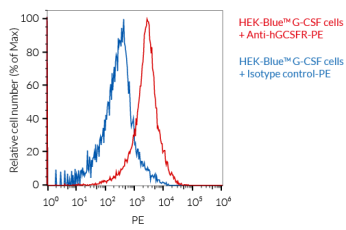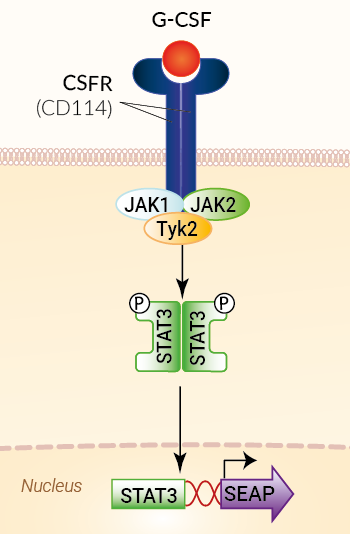HEK-Blue™ G-CSF Cells
-
Cat.code:
hkb-gcsf
- Documents
ABOUT
G-CSF responsive STAT3-SEAP reporter assay
HEK-Blue™ G-CSF cells are designed to monitor granulocyte colony-stimulating factor (G-CSF)-induced STAT3 stimulation or inhibition. This colorimetric bioassay can be used for screening activatory molecules, such as engineered cytokines, or inhibitory molecules, such as neutralizing antibodies.
G-CSF reporter cells detect recombinant human G-CSF as well as mouse G-CSF (see figures). They also respond, to a weaker extent, to two other human STAT3-signaling cytokines, IL-6 and IL-27, as they endogenously express the gp130 co-receptor shared by these cytokine receptors. However, they do not respond to human type I IFNs (IFN-α/IFN-β) (see figures).
The reliable and consistent performance of HEK-Blue™ G-CSF cells makes them suitable for release assays of therapeutic molecules that inhibit the G-CSF pathway, such as monoclonal antibodies (see figures).
Key features
- Readily assessable STAT3-inducible SEAP reporter activity
- Convenient readout using QUANTI-Blue™ Solution
- Strong response to human (h) and mouse (m) C-CSF
- Weak response to IL-6 and IL-27
- No response to human type I IFNs
Applications
- Therapeutic development
- Drug screening
- Release assay
G-CSF is a secreted cytokine and hematopoietic growth factor. It regulates the differentiation, proliferation, and function of neutrophils [1].
Disclaimer: These cells are for internal research use only and are covered by a Limited Use License (See Terms and Conditions). Additional rights may be available.
SPECIFICATIONS
Specifications
G-CSF
Human, Mouse
Detection and quantification of G-CSF activity
300 pg/ml - 100 ng/ml (hG-CSF, mG-CSF)
Complete DMEM (see TDS)
Verified using Plasmotest™
Each lot is functionally tested and validated.
CONTENTS
Contents
-
Product:HEK-Blue™ G-CSF Cells
-
Cat code:hkb-gcsf
-
Quantity:3-7 x 10^6 cells
- 2 x 1 ml of HEK-Blue Selection (250X)
- 1 ml Normocin® (50 mg/ml)
- 1 ml of QB reagent and 1 ml of QB buffer (sufficient to prepare 100 ml of QUANTI-Blue™ Solution, a SEAP detection reagent).
Shipping & Storage
- Shipping method: Dry ice
- Liquid nitrogen vapor
- Upon receipt, store immediately in liquid nitrogen vapor. Do not store cell vials at -80°C.
Storage:
Caution:
Details
Cell line description
HEK-Blue™ G-CSF cells were generated from the human embryonic kidney HEK 293 cell line by the stable transfection with the genes encoding for the human CSF receptor (CSFR, aka CD114), human STAT3c, and a STAT3-inducible secreted embryonic alkaline phosphatase (SEAP) reporter. The binding of G-CSF to its receptor triggers a signaling cascade leading to the activation of STAT3 and the subsequent production of SEAP. This can be readily assessed in the supernatant using QUANTI-Blue™ Solution, a SEAP detection reagent.
Granulocyte colony-stimulating factor background
The granulocyte colony-stimulating factor (G-CSF) is a secreted cytokine and hematopoietic growth factor that belongs to the Type I/II cytokine receptor family. G-CSF regulates the differentiation, proliferation, and function of neutrophils [1]. It exerts its biological functions through the formation of a tetramer consisting of two G-CSF molecules and the homodimeric G-CSF receptor (GCSFR, aka CD114). The binding of G-CSF to its receptor triggers activation of the JAK/STAT signaling pathway [1,2]. STAT1, STAT3, and STAT5 are involved in this activation step and the induction of cellular proliferation [1,2]. Studies in humans and mice indicate that while G-CSF contributes to host defense against pathogens, it can also have detrimental effects by promoting inflammatory diseases and cancer [1,2].
References:
1. Martin KR., et al., 2021. G-CSF — A double-edged sword in neutrophil-mediated immunity. Sem Immunol. 54:101516.
2. Park, DS., et al., 2022. A review of granulocyte colony-stimulating factor receptor signaling and regulation with implications for cancer. Front Oncol. DOI: 10.3389/fonc.2022.932608.
DOCUMENTS
Documents
Technical Data Sheet
Validation Data Sheet
Safety Data Sheet
Certificate of analysis
Need a CoA ?






